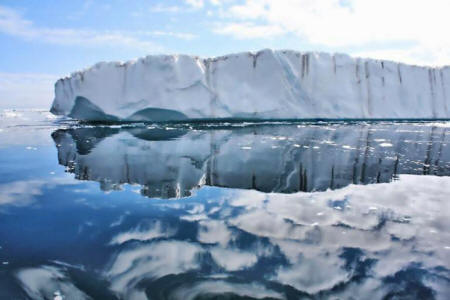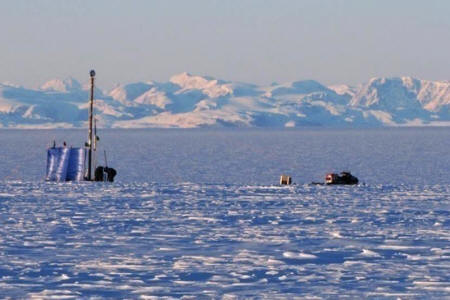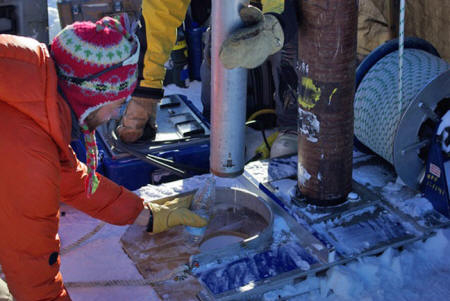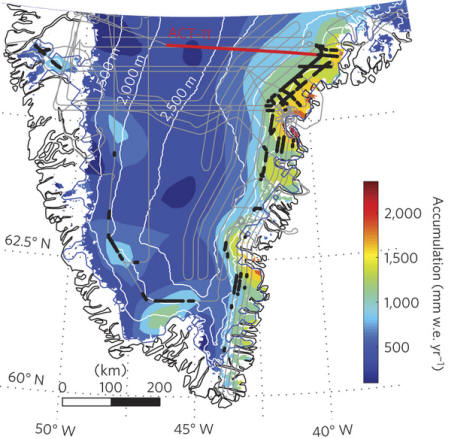|
by Philip Ross
Greenland is home to the second largest sheet of ice in the world,
behind Antarctica.
According to new analysis, a massive
reservoir of melt water is trapped underneath the frozen landscape
of the Greenland ice sheet, where temperatures often hover below
zero degrees Fahrenheit.
The water was found at a depth of 33 feet in the first drill and 82 feet in the second, according to the study (Extensive liquid meltwater storage in firn within the Greenland ice sheet) published Sunday in the journal Nature Geoscience.
(Note: read also the study "Evidence of Meltwater Retention within the Greenland Ice Sheet".)
The team expected to find layers of dry snow, which was the case during other drills. Also, it was early spring, so there was not yet an opportunity for surface melt to seep into the subsurface.
Because of this, researchers concluded
that the water remained trapped underneath the surface year-round.
from
PHYS Website
This drill rig was used to extract firn cores from within the Greenland firn aquifer. One of the snowmobiles used in the 186 mile traverse of the ice sheet to reach the drill site. Clément Miège, University of Utah Ph.D. student and Terry Gacke, Ice Drilling Design and Operations.
Credit: Evan Burgess
The aquifer is extensive, covering 27,000 square miles.
The reservoir is known as a "perennial firn aquifer" because water persists within the firn - layers of snow and ice that don't melt for at least one season. Researchers believe it figures significantly in understanding the contribution of snowmelt and ice melt to rising sea levels.
The study was published online Sunday, Dec. 22, in the journal Nature Geoscience.
Rick Forster's team has been doing research in southeast Greenland since 2010 to measure snowfall accumulation and how it varies from year to year.
The area they study covers 14 percent of southeast Greenland yet receives 32 percent of the entire ice sheet's snowfall, but there has been little data gathered. In 2010, the team drilled core samples in three locations on the ice for analysis. Team members returned in 2011 to approximately the same area, but at lower elevation.
Of the four core samples taken then, two came to the surface with liquid water pouring off the drill while the air temperatures were minus 4 degrees Fahrenheit.
The water was found at about 33 feet below the surface at the first hole and at 82 feet in the second hole.
The aquifer is extensive, covering 27,000 square miles - larger than the state of West Virginia.
It is similar in form to a groundwater aquifer on land that can be used for drinking water.
Why Studying Ice in Greenland is Important
The Greenland Ice Sheet is vast, covering roughly the same area as the states of California, Nevada, Arizona, New Mexico, Colorado and Utah combined.
The average thickness of the ice is 5,000 feet. In 2012, the ice sheet lost volume of 60 cubic miles - a record for melt and runoff.
The consequences of losing the ice sheet could be catastrophic. If all the water retained in the ice sheet melted, it is estimated that the global sea level would rise about 21 feet, says Forster. Although no one is predicting a total melt-off all at once, keeping an eye on ice formation, runoff amounts and how the water is moving is critical to accurately predicting sea level changes.
Until now, calculations of the ice sheet mass changes did not include a year-round storage mechanism for liquid water. Models predicted that water either flowed into rivers and lakes on the ice surface, into crevasses and subglacial streams that eventually run into the sea, or was refrozen within the ice sheet.
Discovery of the perennial aquifer will help scientists predict the movement and temperature of water within the ice sheet with more precision.
Forster says the reservoir's exact role is unknown.
As for whether climate change caused the aquifer to form, Forster says that's not clear, but simulations of the Greenland Ice Sheet going back to the early 1970s would suggest it has been around for some time.
How the Study was Conducted
The previously unknown storage mode was found in the southeast section of Greenland, where conditions combine to provide sufficient rain and snowmelt to fill the firn with water, as well as high levels of snow accumulation that insulate the water from freezing during the winter.
The team used data collected by airborne and ground-penetrating radar to pinpoint the aquifer, and then took core samples on the ground.
Airborne radar imagery was collected in the area by NASA Operation IceBridge, which is a program directed at collecting images of Earth's polar ice in unprecedented detail to better understand the processes that connect polar regions with climate change.
Ground-penetrating radar and a roving Global Positioning System navigation unit also were towed across the ice in the same area via snowmobile, collecting data every five seconds.
Researchers found that the radar images from air and ground corresponded on both the depth of a bright horizon, indicating where there is a change in consistency of the ice, as well as the undulations of the horizon across distance of about 15 miles.
This was confirmation that the airborne radar could map the aquifer just as well as the ground-based radar.
Core samples were taken with a 4-inch-diameter drill. Two segments were extracted that were saturated with liquid water - one from a depth of about 33 feet and another the following day about a mile east and at a depth of more than 80 feet.
Temperatures in the spring of 2011 were below average.
Forster notes that,
This research is an international collaboration among researchers at,
Forster and the Utah team were supported by the National Science Foundation and NASA.
Annual snow accumulation (1958-2008) from
regional climate
model with output calibrated by ice core values (colour). The ACT-11 traverse is red. Locations of radar-retrieved firn aquifer positions from the OIB accumulation radar are illustrated as black dots.
|




